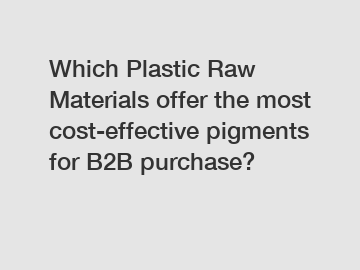Which Plastic Raw Materials offer the most cost-effective pigments for B2B purchase?
Which Plastic Raw Materials offer the most cost-effective pigments for B2B purchase?
Plastic plays an integral role in various industries, providing versatility, durability, and affordability. However, to enhance the aesthetic appeal of plastic products, pigments are often added during the manufacturing process. These pigments not only impart color but also contribute to the overall cost of the final product. Therefore, selecting the most cost-effective pigments becomes crucial for businesses. In this article, we will delve into various plastic raw materials that offer the most economical pigments for B2B purchases.
1. Polyethylene (PE):

Polyethylene is one of the most widely used plastic materials, primarily due to its low cost and versatility. When it comes to pigmentation, PE offers a range of cost-effective solutions. The most commonly used pigment for PE is titanium dioxide (TiO2), which provides excellent coverage and UV resistance. It offers a brilliant white shade that is highly desired in many industries. Additionally, carbon black is an excellent pigment for black pigmentation in PE, offering good tinting strength and UV stabilization.
2. Polypropylene (PP):
Polypropylene is another popular plastic material known for its cost-effectiveness and high chemical resistance. Similar to PE, titanium dioxide is a commonly used pigment for achieving vibrant white shades in PP products. Additionally, organic pigments, such as phthalocyanine blues and greens, are widely used to achieve a broad range of colors in PP. These organic pigments are highly cost-effective and offer good lightfastness and weatherability.
3. Polyvinyl Chloride (PVC):
PVC is a versatile plastic material widely used in construction, automotive, and packaging industries. It offers excellent durability and fire resistance properties. For cost-effective pigmentation in PVC, various options are available. Iron oxide pigments, such as red and yellow iron oxides, are commonly used in PVC applications. They offer good opacity, color stability, and cost-effectiveness. In addition, lead-based pigments are traditionally used in PVC, but due to environmental concerns, alternatives like titanium dioxide and organic pigments are gaining popularity.
4. Polystyrene (PS):
Polystyrene is a commonly used plastic material in the food packaging industry due to its clarity and excellent barrier properties. Pigments for polystyrene can be selected based on the desired transparency or opacity of the final product. For transparent applications, dyes are commonly used, while titanium dioxide is used to achieve opacity. The pigment selection in polystyrene can vary depending on the specific application requirements, making it essential to consider cost-effectiveness.
5. Polyethylene Terephthalate (PET):
PET is a thermoplastic material widely used in the packaging industry, particularly for water bottles and food containers. Cost-effective pigmentation options for PET include organic pigments like phthalocyanine blues and greens, which offer good lightfastness and weatherability. Titanium dioxide is also used for achieving white shades in PET. However, it is important to note that due to the transparency of PET, achieving intense colors may require higher pigment loadings, potentially impacting cost-effectiveness.
In conclusion, the choice of cost-effective pigments for B2B purchases depends on the specific plastic materials used and the desired properties of the final product. Polyethylene, polypropylene, polyvinyl chloride, polystyrene, and polyethylene terephthalate are widely used plastic raw materials that offer various economical pigmentation options. Titanium dioxide, organic pigments, and iron oxide pigments are commonly used, providing different color options and performance attributes. It is crucial for businesses to consider the specific requirements of their products and weigh the cost-effectiveness of different pigment options to make informed decisions for B2B purchases.
Want more information on gpps plastic material manufacturers, polystyrene raw material, gpps plastic material? Feel free to contact us.
104
0
0

Comments
All Comments (0)